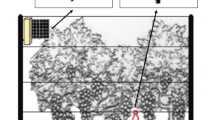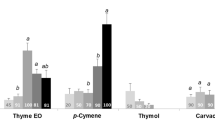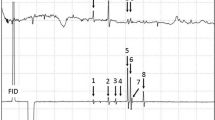Abstract
Disruption experiments were carried out under vineyard conditions and in the laboratory. Males from laboratory cultures were conditioned in an atmosphere permeated with pheromone (E7 Z9-12Ac), marked externally with fluorescent powder, and released in the middle of vine plots. They were then trapped in a series of traps baited with virgin females or dispensers loaded with various amounts of pheromone. Over 10,000 males were released in these experiments between 19 May and 22 July. Electroantennography tests were used for studying olfactory sensitivity in pheromone-permeated air by measuring the EAG responses of male antennae in constant pheromone air-flows. The conclusion is that both sensory adaptation and central nervous system habituation mechanisms acted simultaneously in air laden with pheromone, but they are probably not relevant when concentrations are of the same order of magnitude as those obtained under field conditions in which mating disruption methods are used for controlling the European grape moth.
Similar content being viewed by others
REFERENCES
BAKER, T. C., MEYER, W. L., and ROELOFS, W. L. 1981. Sex pheromone dosage and blend specificity of response by Oriental Fruit moth males. Entomol. Exp. Appl. 30:269–279.
BAKER, T. C., HANSSON, B. S., LOSTEDT, C., and LOFQVIST, J. 1988. Adaptation of antennal neurons in moths in associated of pheromone-mediated upwind flight. Proc. Natl. Acad. Sci. USA 85:9826–9830.
CARDE, R. T. 1990. Principles of mating disruption, pp. 41–47, in R. L. Ridgway, R. M. Silverstein, and M. N. Inscoe (eds.). Behavior Modifying Chemicals for Insect Management. Applications of Pheromones and Other Attractants. Marcel Dekker, New York.
CARLES, J. P., FLEURAT-LESSARD, F., and ROEHRICH, R. 1979. Un appareil pour les essais biologiques de comportement des lépidoptères exposés à des doses élevées d'attractif sexuel. Biol. Behav. 4:205–217.
FLINT, H. M., YAMAMOTO, A., PARKS, M. J., and NYOMURA, K. 1990. Aerial concentrations of Gossyplure, the sex pheromone of the pink bollworm, in cotton fields treated with long lasting dispensers. Environ. Entomol. 19(6):1845–1851.
KUENEN, L. P. S., and BAKER, T. C. 1981. Habituation versus sensory adaptation as the cause of reduced attraction following pulsed and constant sex pheromone pre-exposure in Trichoplusia ni. J. Insect Physiol. 27(10):721–726.
ROEHRICH, R., and CARLES, J. P. 1987. Biological observations during mating disruption experiments of Lobesia botrana, pp. 45–46, in H. Arn (ed.). Utilisation des phéromones et autres médiateurs chimiques en lutte intégrée, C. R. Groupe de travail Neustadt, 8–12 Sept. 1986. SROP/OILB IX, p. 13.
SANDERS, C. J. 1985. Disruption of spruce budworm, Choristoneura fumiferana (Lepidoptera: Tortricidae), mating in a wind tunnel by synthetic pheromone: Role of habituation. Can. Entomol. 117:391–393.
SAUER, A. E., KARG, G., KOCH, U. T., DE KRAMER, J. J., and MILLI, R. 1992. A portable EAG system for the measurement of pheromone concentrations in the field. Chem. Senses. 17:543–553.
SCHERRER, B. 1984. Biostatistique. Gaëtan Morin, Québec.
SCHMITZ, V., ROEHRICH, R., and STOCKEL, J. 1995a. Etude du mécanisme de la confusion sexuelle chez l'Eudémis de la vigne (Lobesia botrana Den et Schiff.). I. Rôles respectifs de la compétition, du camouflage de la piste ordorante et de la modification du signal phéromonal. J. Appl. Entomol. 119:131–138.
SCHMITZ, V., ROEHRICH, R., and STOCKEL, J. 1995b. Disruption mechanisms of pheromone communication in the European grape moth (Lobesia botrana Den. & Schiff.). II. Influence of the population density and the distance between insects for males to detect the females in atmosphere impregnated by pheromone. J. Appl. Entomol. 119:303–308.
STOCKEL, J. 1977. Mise au point d'un type de piège sexuel “INRA” pour insectes, pp. 12–14, in Les phéromones sexuelles des lépidoptères. C.R. Réunion Bordeaux 13–16 Oct. 1976, INRA, Bordeaux.
STOCKEL, J., ROEHRICH, R., CARLES, J. P., and NADAUD, A. 1989. Technique d'élevage pour l'obtention programmée d'adultes vierges d'Eudémis. Phytoma 412:205–217.
STOCKEL, J., SCHMITZ, V., LECHARPENTIER, P., ROEHRICH, R., TORRES VILLA, M., and NEUMANN, U. 1994. La confusion sexuelle chez l'Eudemis Lobesia botrana (Lepidoptera Tortricidae). Bilan de cinq années d'expérimentation dans un vignoble bordelais. Agronomie 2:71–82.
Author information
Authors and Affiliations
Rights and permissions
About this article
Cite this article
Schmitz, V., Renou, M., Roehrich, R. et al. Disruption Mechanisms of Pheromone Communication in the European Grape Moth Lobesia botrana Den & Schiff. III. Sensory Adaptation and Habituation. J Chem Ecol 23, 83–95 (1997). https://doi.org/10.1023/B:JOEC.0000006347.86822.17
Issue Date:
DOI: https://doi.org/10.1023/B:JOEC.0000006347.86822.17




